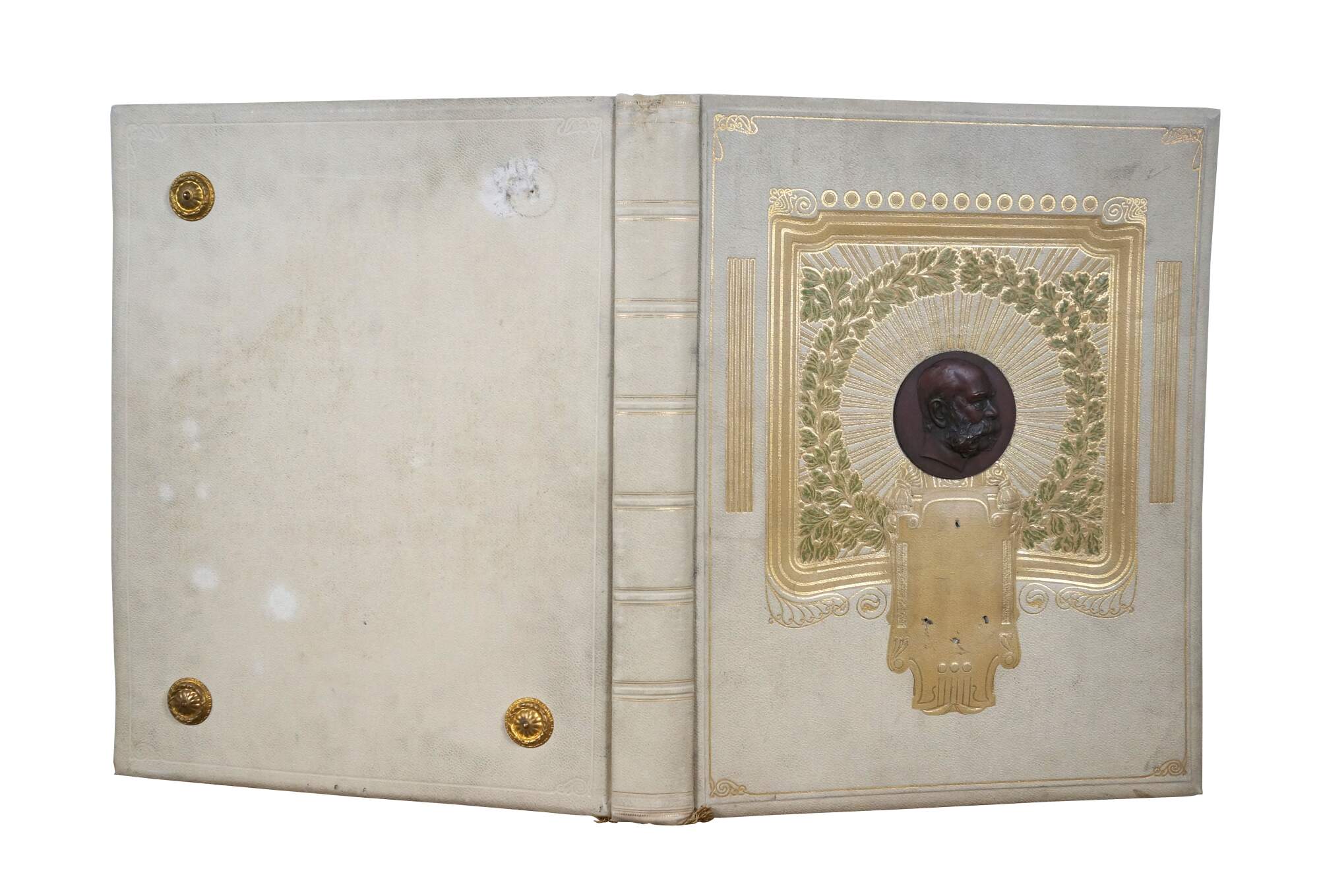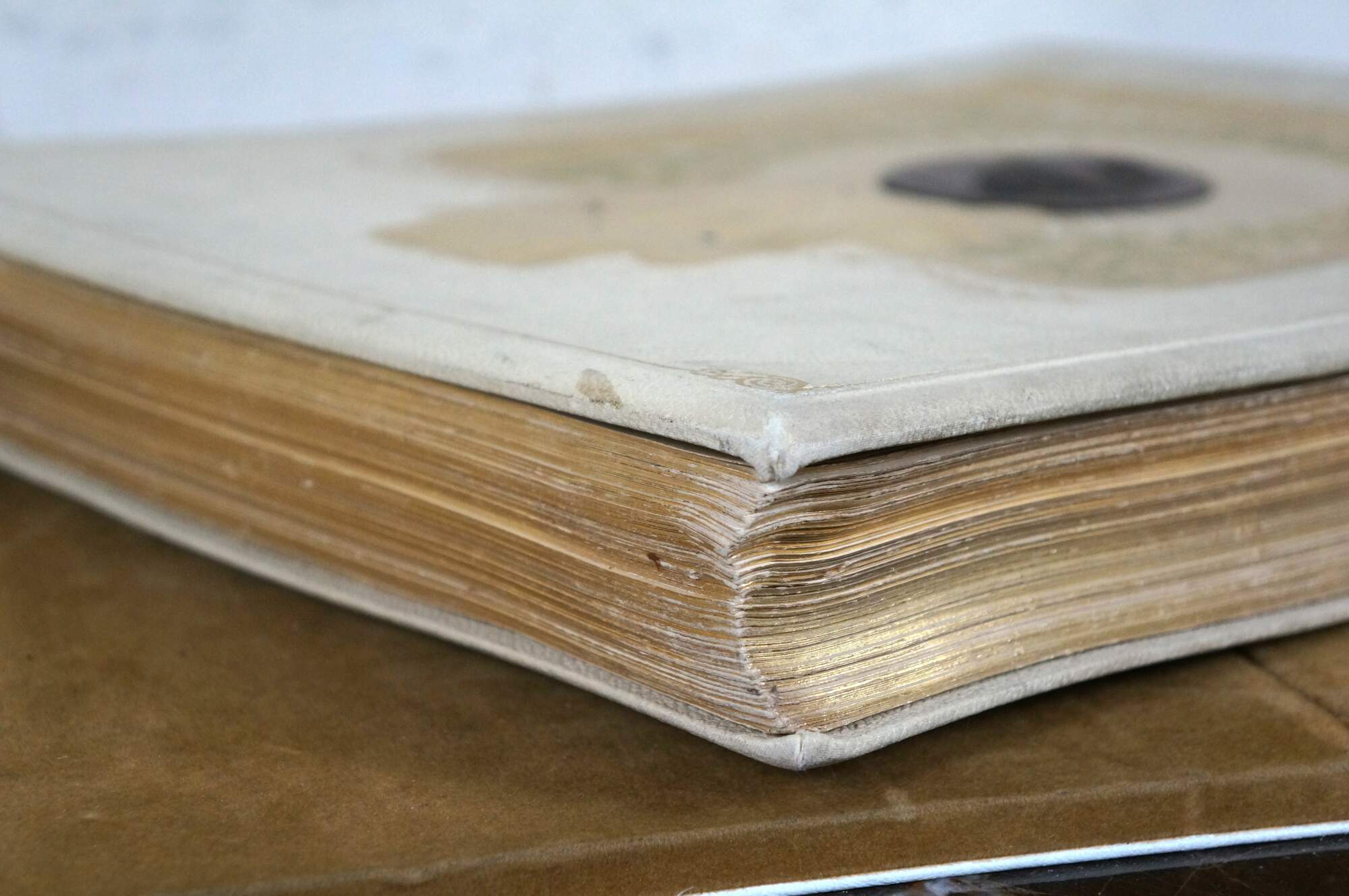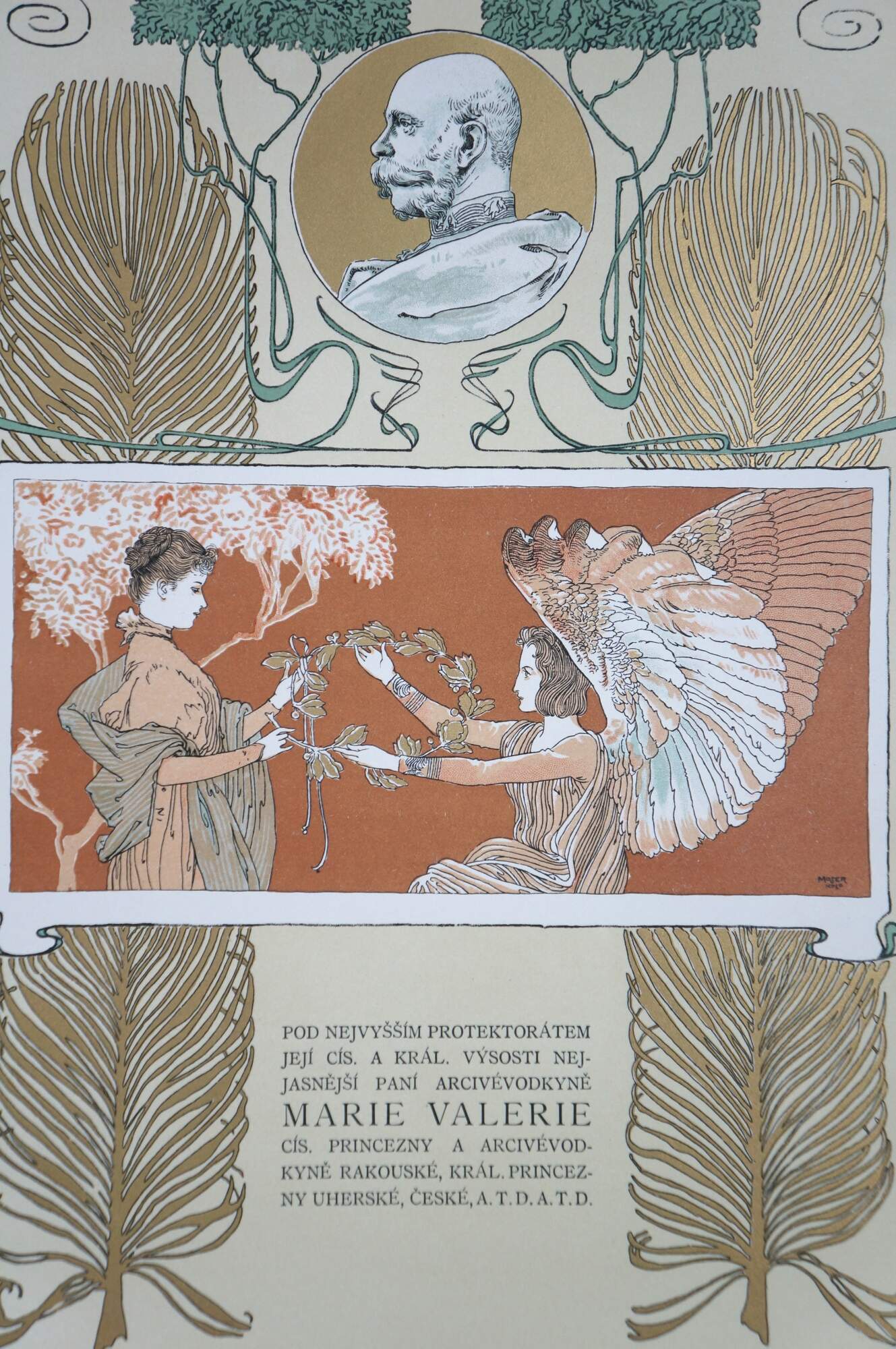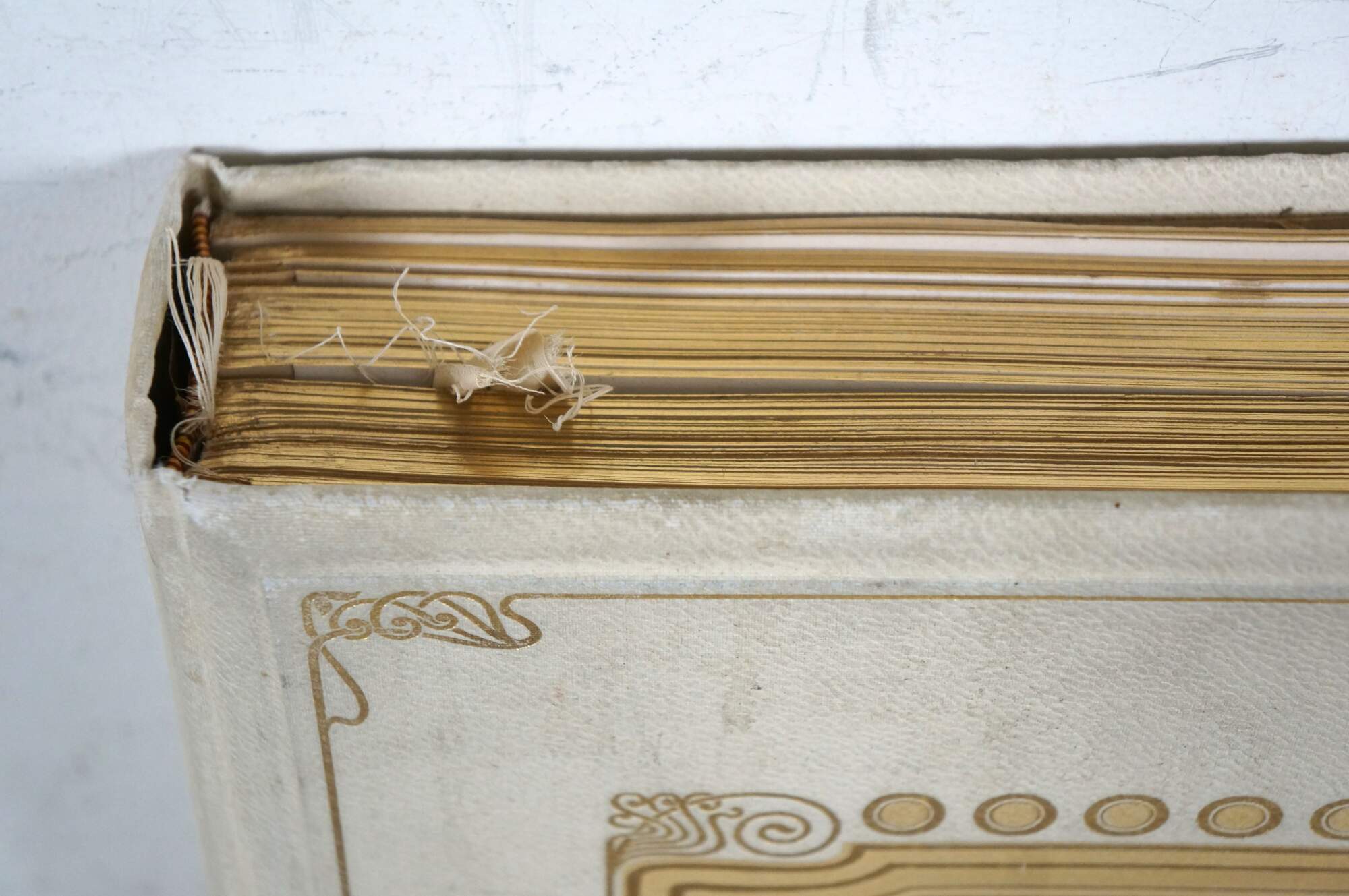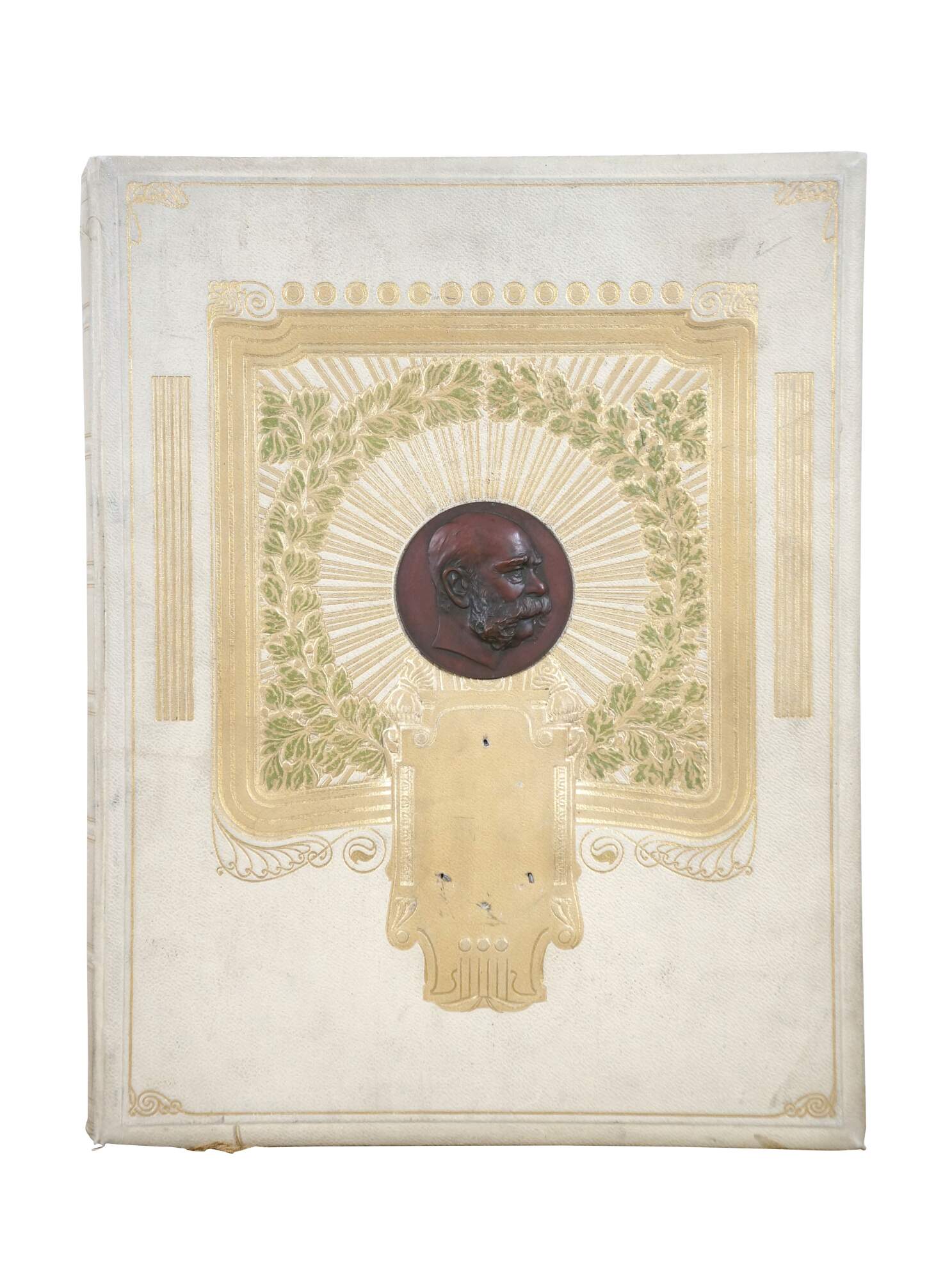
Antique Viribus Unitis Kniha o Cisari Book of the Emperor Franz Joseph I 18"
$1,000.00
Shipping:
Free Shipping Included
Delivery:
Estimated 2-15 Business Days
Payments:
Credit Card, Check, Cash, PayPal, Apple Pay, Venmo
Returns:
30 Days 100% Money Back Guarantee, Buyer Pays Return Shipping
Description
Rare antique late 19th Century hard bound, leather book of heliogravure prints memorialising the 50th Anniversary of the coronation of Emperor Franz Joseph I of Austria. Includes stunning Art Nouveau title and content pages by Koloman Moser. Language: Czech / Slovak. More commonly found in German (Das Buch von Kaiser).
Viribvs Vnitis - Kniha o Cisari - S 28 Heliogravurni - Mi Umeleckymi Prilo - Hami, 3 Barevnymi ume - Leckymi Listy a 100 Celo - Strankovymi Obrazy (Book of the Emperor - With 28 Heliogravure - Art Illustrations, 3 Coloured Art - Illustrations and 100 Full - Page Images). Pod nejvyssim protektoratem jeji cis. A kral. Vysosti nej-jasnejsi pani archivevodkyne Marie Valerie cis. princezny a archivevod-kyne rakouske, kral. Princez-ny uherske, ceske, A.T.D.A.T.D. (Under the highest protectorate of Her Majesty and King. Her Most Serene Highness Archduchess Marie Valerie, Princess and Archduchess of Austria, King. Princesses of Hungary, Bohemia, A.T.D.A.T.D). Viden - Lipsko - Nakladem Maxe Herziga (Vienna - Leipzig - Published by Max Herzig). Hard back / hard cover, white leather binding with gilt and painted details and applied feet and accent pieces.
"Franz Joseph I or Francis Joseph I (18 August 1830 – 21 November 1916) was Emperor of Austria, King of Hungary, and the ruler of the other states of the Habsburg monarchy from 1848 until his death in 1916. In the early part of his reign, his realms and territories were referred to as the Austrian Empire, but were reconstituted as the dual monarchy of Austria-Hungary in 1867. From 1 May 1850 to 24 August 1866, he was also president of the German Confederation. In December 1848, Franz Joseph's uncle Emperor Ferdinand I abdicated the throne at Olomouc, as part of Minister President Felix zu Schwarzenberg's plan to end the Hungarian Revolution of 1848. Franz Joseph then acceded to the throne. In 1854, he married his first cousin, Duchess Elisabeth in Bavaria, with whom he had four children: Sophie, Gisela, Rudolf, and Marie Valerie. Largely considered to be a reactionary, Franz Joseph spent his early reign resisting constitutionalism in his domains. The Austrian Empire was forced to cede its influence over Tuscany and most of its claim to Lombardy–Venetia to the Kingdom of Sardinia, following the Second Italian War of Independence in 1859 and the Third Italian War of Independence in 1866. Although Franz Joseph ceded no territory to the Kingdom of Prussia after the Austrian defeat in the Austro-Prussian War, the Peace of Prague (23 August 1866) settled the German Question in favour of Prussia, which prevented the unification of Germany from occurring under the House of Habsburg.” Franz Joseph was troubled by nationalism throughout his reign. He concluded the Austro-Hungarian Compromise of 1867, which granted greater autonomy to Hungary and created the dual monarchy of Austria-Hungary. He ruled peacefully for the next 45 years, but personally suffered the tragedies of the execution of his brother, Emperor Maximilian I of Mexico, in 1867, the suicide of his son, Rudolf, in 1889, and the assassinations of his wife, Elisabeth, in 1898 and his nephew and heir presumptive, Archduke Franz Ferdinand, in 1914. After the Austro-Prussian War, Austria-Hungary turned its attention to the Balkans, which was a hotspot of international tension because of conflicting interests of Austria with not only the Ottoman but also the Russian Empire. The Bosnian Crisis was a result of Franz Joseph's annexation in 1908 of Bosnia and Herzegovina, which had already been occupied by his troops since the Congress of Berlin (1878). On 28 June 1914, the assassination of Archduke Franz Ferdinand in Sarajevo resulted in Austria-Hungary's declaration of war against the Kingdom of Serbia, which was an ally of the Russian Empire. This activated a system of alliances declaring war on each other, which resulted in World War I. Franz Joseph died in 1916, after ruling his domains for almost 68 years. He was succeeded by his grandnephew, Charles I & IV." (Source: Wikipedia)
"Koloman Moser (30 March 1868 – 18 October 1918) was an Austrian artist who exerted considerable influence on twentieth-century graphic art. He was one of the foremost artists of the Vienna Secession movement and a co-founder of Wiener Werkstätte. Moser designed a wide array of artworks, including books and graphic works from postage stamps to magazine vignettes; fashion; stained glass windows, porcelain and ceramics, blown glass, tableware, silver, jewellery, and furniture. Moser was born in Vienna in 1868 to parents Josef and Thresia Moser (née Hirsch); he was the oldest of three siblings. He studied at the Wiener Akademie and the Kunstgewerbeschule, where he also taught from 1899. Moser's designs in architecture, furniture, jewellery, graphics, and tapestries helped characterise the work of this era. He drew upon the clean lines and repetitive motifs of classical Greek and Roman art and architecture in reaction to the Baroque decadence of his turn-of-the-century Viennese surroundings. Between 1900 and 1902, he published with Martin Gerlach and Carl Otto Czeschka a three-volume portfolio titled Die Quelle ("The Source") of elegant graphic designs for such things as tapestries, fabrics, and wallpaper. In 1903, Moser and his colleague Josef Hoffmann founded Wiener Werkstätte, whose studios and artisans produced a number of aesthetically and functionally designed household goods, including glassware, flatware, silverware, rugs, and textiles. In 1904, he created the Apse mosaic and glass windows for the Kirche am Steinhof in Vienna, and designed the decoration of the Medallion House of the Linke Wienzeile Buildings for architect Otto Wagner. In 1905, together with the Klimt group, he separated from the Vienna Secession. The same year, he married Editha (Ditha) Mautner von Markhof, an artist in her own right as well as the daughter of one of Austria's great industry fortunes. Due to internal conflicts and as his plans for reorganising the Werkstätte (to cope with financial problems) weren't realised, Moser withdrew from the Wiener Werkstätte in 1907. Moser became ill with throat cancer in 1916. Correspondence with Alfred Roller detailed Moser's despair over who would succeed him in his position at the University of Applied Arts Vienna. Moser died on 18 October 1918; he was buried three days later in the Hietzing Cemetery. (Source: Wikipedia)
Condition
Good Overall - wear/staining to covers, wear to gilt on page edges; place ribbon detached/damaged, missing emblem on front, missing one grommlet on back, all pages appear intact.
Dimensions
14" x 2.5" x 18.25" (Width x Depth x Height)

